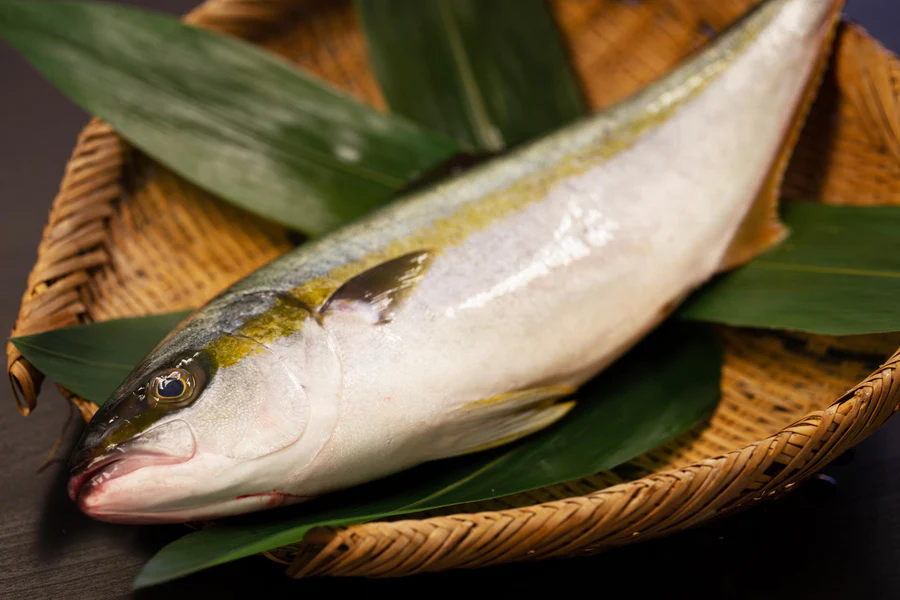Exploring Hiramasa: A Comprehensive Guide to the Kingfish
Hiramasa, often referred to as the yellowtail kingfish or amberjack, is a prized species in the culinary world, known for its delicate flavor, firm texture, and versatility in various cuisines. Whether you’re a professional chef, an enthusiastic home cook, or someone intrigued by exotic seafood, learning about is not only essential but also an exciting journey into the nuances of flavor and sustainable fishing practices. This comprehensive article delves deep into the world of, covering everything from its biology and habitat to its culinary uses, sustainability, and health benefits.
Introduction to Hiramasa: The Yellowtail Kingfish

Hiramasa, scientifically known as Seriola lalandi, is a highly valued species of kingfish that hails from the warm waters of the Pacific and Indian Oceans. It has gained popularity across the globe due to its rich flavor profile and firm, slightly oily texture, making it a favorite in fine dining restaurants, particularly in sushi and sashimi dishes. The name “Hiramasa” is of Japanese origin, which is fitting since Japan has a long history of utilizing this fish in its culinary traditions.
This fish is often confused with other members of the Seriola family, such as hamachi and kampachi, which are also types of yellowtail. However, stands out due to its larger size and leaner flesh, which gives it a distinct taste and texture. The firm, pale pink flesh of is often likened to that of tuna, yet it has a more delicate and sweet flavor, making it perfect for raw preparations as well as various cooked dishes.
As we delve deeper into the specifics of Hiramasa, we will uncover its biological makeup, the environments it thrives in, and the reasons why this fish has become a sought-after delicacy in kitchens worldwide
The Biology and Habitat of Hiramasa
Hiramasa is a migratory species that belongs to the Carangidae family, which includes other species of jacks and pompanos. These fish can grow up to 2 meters in length and weigh over 40 kilograms, although most commercially farmed or caught are typically smaller, ranging between 5 and 10 kilograms. One of the key features of is its elongated, streamlined body, which is built for speed, allowing it to swiftly navigate the open ocean waters.
Habitat and Distribution
Hiramasa can be found in various regions of the Pacific and Indian Oceans, particularly around Japan, Australia, New Zealand, and South Africa. It prefers warm, temperate waters and tends to inhabit coastal areas, often near reefs, rocky shorelines, and oceanic islands. These fish are pelagic, meaning they live in the open ocean, but they often migrate to inshore waters to spawn.
Life Cycle and Behavior
Hiramasa’s life cycle involves spawning in large schools in the open ocean, where the eggs are left to drift with the currents. After hatching, juvenile remain in nursery areas close to shorelines, feeding on smaller fish and crustaceans. As they mature, they move to deeper waters, where their diet expands to include squid, larger fish, and other marine organisms. The diet of significantly contributes to its firm texture and rich flavor, as it is highly carnivorous.
Predators and Role in the Ecosystem
In the wild, Hiramasa plays a significant role as both predator and prey. Its streamlined body and speed make it an effective predator of smaller marine species, while it is also preyed upon by larger fish like sharks, tunas, and marine mammals. As a top-tier predator in the food chain, helps maintain the balance in marine ecosystems by regulating populations of smaller fish and crustaceans.
Hiramasa in Global Fisheries and Aquaculture
Over the past few decades, the demand for has skyrocketed due to its increasing popularity in global cuisines, particularly in sushi bars and high-end restaurants. As a result, both wild-caught and farm-raised are now available in the market, each with its own benefits and challenges.
Wild-Caught Hiramasa
Hiramasa is commercially fished in many regions, with Japan and Australia being two of the largest producers. Wild-caught is typically caught using sustainable fishing methods like hook-and-line or small-scale purse seines. This ensures minimal bycatch and less environmental impact compared to more destructive practices like trawling. Wild is prized for its flavor, as these fish have a more diverse, natural diet.
However, wild populations of can be susceptible to overfishing if not carefully managed. Governments and international bodies are continuously monitoring stocks to prevent depletion, but consumer demand often puts pressure on these populations.
Farm-Raised Hiramasa
To meet growing demand, aquaculture has become a significant source of Hiramasa. Countries like Japan, Australia, and New Zealand have developed sophisticated farming techniques to raise in controlled environments. Farmed has its advantages, including consistent supply, reduced pressure on wild populations, and the ability to control quality and flavor through diet.
Despite these benefits, farmed fish can sometimes have a slightly different flavor or texture due to their controlled diet and environment. However, advancements in aquaculture have led to high-quality farmed that closely mimics its wild counterpart in taste and texture.
Culinary Uses of Hiramasa: A Chef’s Delight
Hiramasa’s versatility in the kitchen is one of the key reasons it has become a favorite among chefs worldwide. Its firm yet tender flesh, mild flavor, and slightly oily texture make it suitable for a wide variety of culinary applications, from raw dishes to elaborate cooked creations. Here, we’ll explore some of the most popular ways is used in the culinary world.
Raw Preparations: Sushi, Sashimi, and Ceviche
Hiramasa is a prized fish in sushi and sashimi cuisine, where its clean, delicate flavor shines. In these raw preparations, the fish is typically sliced thinly and served with minimal seasoning to highlight its natural taste. Its firm texture holds up well to slicing, making it a popular choice for sushi chefs who aim to showcase the quality of the fish.
Ceviche, a popular dish in Latin American cuisine, also utilizes due to its ability to absorb the citrus marinade without losing its integrity. The firm flesh of the fish pairs beautifully with tangy lime or lemon juice, herbs, and spices, creating a refreshing and flavorful dish.
Grilled, Seared, and Roasted Dishes
Hiramasa is equally delicious when cooked, thanks to its firm texture that holds up well to heat. Grilling or searing brings out its natural sweetness, while the slight oiliness prevents it from drying out during cooking. The fish can be marinated with a variety of flavors, from citrus-based sauces to soy and ginger combinations, making it a versatile option for both Western and Asian cuisines.
Roasting, especially with aromatic herbs and vegetables, creates a dish that is both light and satisfying. The fish’s natural oils ensure that it remains moist and tender, while the roasting process enhances its subtle flavors.
Smoked Hiramasa
Another popular way to enjoy Hiramasa is by smoking it. The firm flesh of the fish absorbs smoke beautifully, creating a rich, smoky flavor that pairs well with a variety of accompaniments. Smoked can be served on its own, added to salads, or used in more elaborate dishes like smoked fish pâté.
Sourcing and Selecting Fresh Hiramasa
When purchasing Hiramasa, it’s important to select the freshest fish possible to ensure optimal flavor and texture. Whether you’re buying from a local fish market or an online seafood supplier, there are several key indicators to look for when choosing fresh.
Visual Cues for Freshness
The first thing to examine is the fish’s appearance. Fres should have bright, clear eyes and shiny, silver skin with a slight iridescence. The flesh should be firm to the touch and have a slighttranslucent appearance. Avoid fish that looks dull, has cloudy eyes, or feels soft and mushy, as these are signs that it may not be fresh.
Smell Test
Fresh Hiramasa, like any high-quality seafood, should have a clean, briny smell reminiscent of the ocean. If the fish has a strong, fishy odor, it is likely past its prime and should be avoided. The smell test is one of the simplest yet most effective ways to gauge the freshness of the fish.
Checking for Sustainability Certifications
If you’re conscious about the environmental impact of your seafood choices, look for that has been certified by organizations like the Marine Stewardship Council (MSC) or Aquaculture Stewardship Council (ASC). These certifications indicate that the fish has been caught or farmed in a sustainable manner, ensuring minimal impact on wild populations and the environment.
Sustainable Fishing Practices and Aquaculture of Hiramasa
With the increasing demand for seafood and the growing awareness of environmental issues, sustainable fishing practices and responsible aquaculture are more important than ever. Hiramasa, being a high-demand species, has faced pressure from overfishing in certain regions. However, significant strides have been made in both wild fisheries management and aquaculture to ensure the long-term viability of populations.
Sustainable Wild Fisheries
In regions like Japan and Australia, where wild Hiramasa is commercially fished, strict regulations have been implemented to prevent overfishing and maintain healthy populations. These regulations include catch limits, seasonal fishing bans, and the use of environmentally friendly fishing methods, such as hook-and-line fishing, which minimizes bycatch and damage to marine ecosystems.
Marine conservation organizations work closely with these fisheries to monitor stock levels and implement measures that protect the species from overexploitation. Sustainable fishing practices not only ensure that future generations can continue to enjoy, but they also help preserve the health and biodiversity of the oceans.
Responsible Aquaculture
Aquaculture, or fish farming, has become a crucial component of the seafood industry, particularly for species like Hiramasa that are in high demand. Responsible aquaculture practices focus on minimizing the environmental impact of fish farms by reducing waste, preventing disease outbreaks, and using sustainable feed sources.
Countries like Japan, Australia, and New Zealand have developed highly efficient aquaculture systems for that ensure a steady supply of high-quality fish without compromising the environment. These farms are often located in coastal areas where the water quality is regularly monitored, and fish are raised in controlled environments that mimic their natural habitats.
Health Benefits of Hiramasa
In addition to its culinary appeal, Hiramasa is also known for its numerous health benefits. Like many other fish, it is rich in essential nutrients that contribute to overall health and well-being. Whether you’re looking to improve your heart health, boost your immune system, or simply enjoy a nutritious meal, offers a wide range of health benefits.
Rich in Omega-3 Fatty Acids
One of the primary health benefits of Hiramasa is its high content of omega-3 fatty acids, particularly eicosapentaenoic acid (EPA) and docosahexaenoic acid (DHA). These essential fatty acids are known for their anti-inflammatory properties and their ability to support heart health. Regular consumption of omega-3s has been linked to a reduced risk of heart disease, lower blood pressure, and improved cholesterol levels.
High-Quality Protein Source
Hiramasa is an excellent source of high-quality protein, which is essential for muscle repair, immune function, and overall growth and development. Protein is particularly important for individuals who lead active lifestyles or are looking to build and maintain lean muscle mass. A serving of provides a significant amount of protein, making it a great addition to a balanced diet.
Low in Calories and Saturated Fat
For those who are health-conscious or looking to manage their weight, is a low-calorie, low-fat option that still delivers on flavor and nutrition. The fish is naturally low in saturated fat, making it a heart-healthy choice for individuals aiming to reduce their intake of unhealthy fats. Its lean profile means you can enjoy without worrying about excess calories or unhealthy fats.
Popular Dishes and Recipes Featuring Hiramasa
Hiramasa’s versatility in the kitchen has led to the creation of numerous dishes that highlight its delicate flavor and firm texture. From sushi and sashimi to grilled or roasted preparations, there are countless ways to enjoy this delicious fish. Here, we’ll explore some of the most popular dishes featuring and offer some recipe ideas for you to try at home.
Hiramasa Sashimi
One of the most iconic ways to enjoy Hiramasa is as sashimi. The fish is sliced thinly and served raw, often with soy sauce, wasabi, and pickled ginger on the side. The clean, delicate flavor of shines in this preparation, making it a favorite in Japanese cuisine. To make sashimi at home, all you need is fresh, high-quality, a sharp knife, and a few simple accompaniments.
Grilled Hiramasa with Citrus Soy Glaze
Grilled Hiramasa is another popular dish that showcases the fish’s natural sweetness and firm texture. To make a simple yet flavorful grilled dish, marinate the fish in a mixture of soy sauce, citrus juice (like lemon or lime), garlic, and ginger. Grill the fish over medium-high heat until it’s cooked through but still tender. Serve with steamed vegetables or a light salad for a healthy, satisfying meal.
Hiramasa Ceviche
For a refreshing and zesty dish, try making Hiramasa ceviche. This Latin American-inspired dish involves marinating the fish in lime or lemon juice, which “cooks” the fish by denaturing the proteins. Add diced onions, cilantro, and chili peppers for a burst of flavor and color. Serve with tortilla chips or on a bed of lettuce for a light, flavorful appetizer or main course.
Cooking Techniques for Hiramasa
Hiramasa’s versatility extends to the various cooking techniques that can be used to prepare it. Whether you prefer grilling, roasting, pan-searing, or poaching, firm texture and delicate flavor make it a great candidate for a wide range of culinary methods.
Grilling Hiramasa
Grilling is one of the best ways to cook Hiramasa, as it brings out the natural sweetness of the fish while imparting a smoky flavor. To grill, start by marinating the fish in your favorite marinade—citrus-based sauces work particularly well. Preheat your grill to medium-high heat and cook the fish for about 3-4 minutes on each side, or until it’s opaque and flakes easily with a fork.
Roasting Hiramasa
Roasting Hiramasa is another excellent option, especially if you’re looking to create a hearty, flavorful dish. To roast, season the fish with herbs, olive oil, and a pinch of salt and pepper. Place it on a baking sheet lined with parchment paper and roast in a preheated oven at 375°F (190°C) for about 12-15 minutes, or until the fish is cooked through and tender.
Poaching Hiramasa
Poaching is a gentle cooking method that helps preserve the delicate flavor of Hiramasa. To poach the fish, bring a mixture of water, white wine, and aromatics (such as bay leaves, peppercorns, and lemon slices) to a simmer. Add the fish to the liquid and poach for about 8-10 minutes, or until the fish is cooked through. Serve with a light sauce or over a bed of steamed vegetables.
Storing and Preserving Hiramasa
To enjoy Hiramasa at its best, it’s important to know how to properly store and preserve the fish. Whether you’ve purchased fresh from a market or received a shipment of frozen fillets, following proper storage techniques will ensure that the fish retains its flavor, texture, and nutritional value.
Storing Fresh Hiramasa
If you’ve purchased fresh Hiramasa, it’s best to consume it within 1-2 days to enjoy its optimal freshness. Keep the fish refrigerated at a temperature of 32°F (0°C), which is the ideal temperature for storing seafood. Place the fish on a bed of ice and cover it with plastic wrap to prevent it from drying out. If you’re not planning to eat the fish right away, consider freezing it to extend its shelf life.
Freezing Hiramasa
To freeze Hiramasa, first pat the fish dry with paper towels to remove excess moisture. Wrap the fish tightly in plastic wrap, followed by a layer of aluminum foil or a freezer-safe plastic bag to prevent freezer burn. Label the package with the date and place it in the coldest part of your freezer. Frozen can be stored for up to 3 months without losing much of its quality.
When you’re ready to use the frozen Hiramasa, thaw it in the refrigerator overnight. Avoid thawing the fish at room temperature, as this can lead to uneven thawing and potential bacterial growth.
Preserving Hiramasa by Smoking
Smoking is a popular method for preserving Hiramasa, as it not only extends the shelf life of the fish but also enhances its flavor. Smoked can be stored in the refrigerator for up to a week, or it can be vacuum-sealed and frozen for longer-term storage. Smoked fish is a great addition to salads, sandwiches, or charcuterie boards.
Hiramasa in Sushi and Sashimi Culture
Hiramasa has earned a prominent place in the world of sushi and sashimi, where its firm texture and delicate flavor are highly prized. In Japanese cuisine, sushi and sashimi are considered art forms, and the quality of the fish is paramount. mild, clean flavor makes it a favorite among sushi chefs who want to showcase the natural taste of the fish.
The Art of Sushi: Highlighting Hiramasa
In sushi, the quality of the fish is often paired with carefully seasoned rice, seaweed, and minimal accompaniments. is often used in nigiri sushi, where a slice of fish is placed atop a small mound of rice. The subtle sweetness of the fish complements the seasoned rice, creating a balanced and satisfying bite.
Sashimi, on the other hand, is served without rice, allowing the fish to take center stage. The purity of the fish is emphasized in sashimi, and Hiramasa is often served with a simple garnish of soy sauce, wasabi, and pickled ginger to enhance its flavor.
Pairing Hiramasa with Wine and Other Beverages
Pairing with the right wine or beverage can elevate your dining experience, bringing out the best in both the fish and the drink. Whether you prefer a crisp white wine, a light beer, or a refreshing sake, there are plenty of options to complement the delicate flavor of Hiramasa.
White Wine Pairings for Hiramasa
Crisp, refreshing white wines are an excellent choice for pairing with Hiramasa, as they complement the fish’s mild flavor without overpowering it. Sauvignon Blanc, Chardonnay, and Pinot Grigio are popular options that work well with both raw and cooked dishes.
Sauvignon Blanc, with its bright acidity and citrus notes, pairs beautifully with dishes like grilled Hiramasa or ceviche, while a lightly oaked Chardonnay adds depth and richness to roasted or poached preparations.
Beer and Sake Pairings
If you prefer beer, light and crisp lagers or pilsners are a great match for Hiramasa, especially when it’s served in a sushi or sashimi dish. The lightness of the beer allows the fish to shine, while the carbonation cleanses the palate between bites.
Sake, the traditional Japanese rice wine, is another fantastic pairing for Hiramasa. Opt for a light, dry sake with a clean finish to enhance the delicate flavors of the fish without overwhelming them.
Conclusion
Hiramasa, or yellowtail kingfish, is a prized fish that captivates both chefs and diners alike. Its firm texture, mild flavor, and versatility in the kitchen make it a sought-after ingredient in various global cuisines. Whether enjoyed raw in sushi and sashimi, grilled to perfection, or incorporated into a creative dish, consistently delivers a delightful culinary experience. Furthermore, with its numerous health benefits and the increasing emphasis on sustainable fishing practices and aquaculture, Hiramasa remains a responsibly sourced seafood option that aligns with modern culinary and environmental values.
By exploring its rich history, sustainable practices, health advantages, and diverse cooking techniques, you can appreciate Hiramasa not only for its taste but also for its role in promoting a healthier and more sustainable future for seafood lovers worldwide.








Post Comment